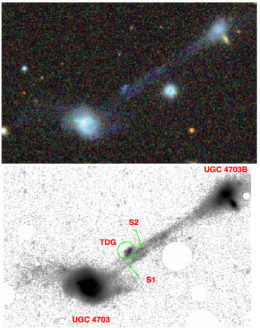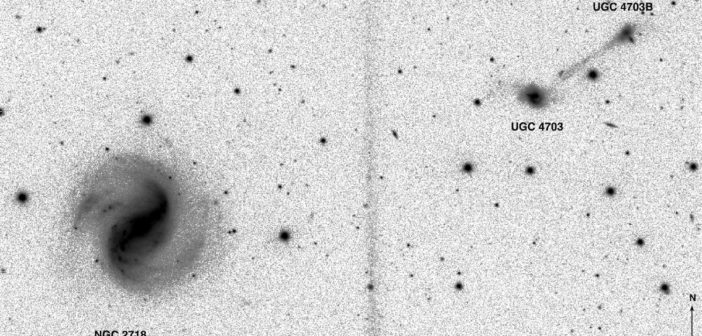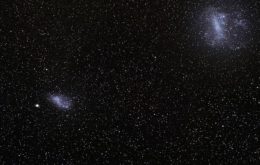A hunt for merging dwarf galaxies has yielded an intriguing result: 180 million light-years away, a galaxy very similar to the Milky Way — with two dwarf-galaxy satellites just like our own Magellanic clouds.
Unusual Satellites
The Large and Small Magellanic clouds (LMC and SMC), the only bright and star-forming satellite galaxies around the Milky Way, have proven unusual in the universe: satellite pairs of LMC–SMC mass are neither common in observation nor typically produced in numerical simulations of galaxy formation and evolution.Since the probability of having such an interacting pair of satellites in a massive halo is so low, this raises questions about how our system came about. Did the Magellanic clouds form independently around the Milky Way and then interact? Were they more recently captured as an already-merging pair of dwarf galaxies? Or is there some other explanation?
If we could find other systems that look like the LMC–SMC–Milky-Way system, we might be able to learn more about pairs of dwarf galaxies and how they interact near the halos of large galaxies like the Milky Way. Conveniently, two researchers from Yonsei University in South Korea, Sanjaya Paudel and Chandreyee Sengupta, have now identified exactly such a system.

The UGC 4703 pair of dwarf galaxies show a stellar bridge connecting them — a sign of their past interaction, when tidal forces stripped material from them as they passed each other. [Adapted from Paudel & Sengupta 2017]
An Interacting Pair
Hunting for merging dwarf galaxies in various environments, Paudel and Sengupta found UGC 4703, an interacting pair of dwarf galaxies that are located near the isolated spiral galaxy NGC 2718. This pair of satellites around the massive spiral bear a striking resemblance to the LMC–SMC system around the Milky-Way.
The authors performed a multi-wavelength study of the system using archival images from the Sloan Digital Sky Survey, The Galaxy Evolutionary Explorer spacecraft, and the Spitzer Space Telescope. They also gather new observations of the H I gas distribution in the system using the Giant Metrewave Radio Telescope in India.
Paudel and Sengupta find that NGC 2718 and the Milky Way have similar stellar masses, and the stellar mass ratio of the UGC 4703 interacting pair is around 5:1, similar to the mass ratio of the LMC to the SMC. The separation of the UGC 4703 pair is also roughly the same as that of the LMC and SMC: ~70,000 light-years.
Similarities and Differences

The H I gas distribution in UGC 4703 reveals both similarities and differences between this system and the LMC–SMC system. [Paudel & Sengupta 2017]
Understanding these similarities and differences between the LMC–SMC–Milky-Way system and this analog are an important first step to studying dwarf galaxy pairs as they interact near the massive halos of their large spiral hosts. In the future, further observations of UGC 4703 and detailed modeling of the system may help continue to puzzle out how our own Magellanic clouds came about.
Citation
Sanjaya Paudel and C. Sengupta 2017 ApJL 849 L28. doi:10.3847/2041-8213/aa95bf


3 Comments
Pingback: Magellanic Clouds twins
Pingback: Quintett und Co.: wenn es auch neben Galaxien glimmt - Abenteuer Astronomie
Pingback: Weitere Artikel dieses Bloggers seit Dezember | Skyweek Zwei Punkt Null